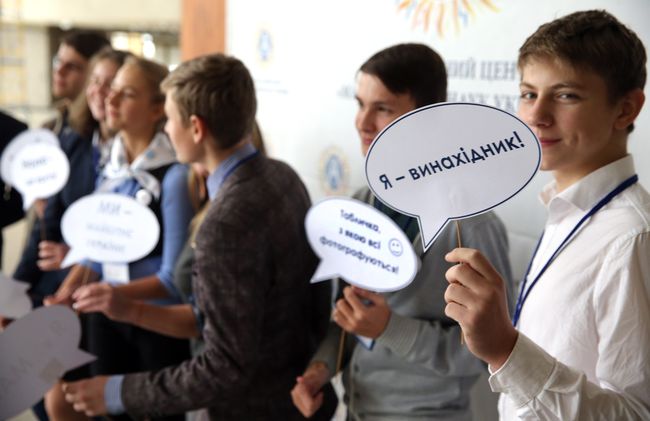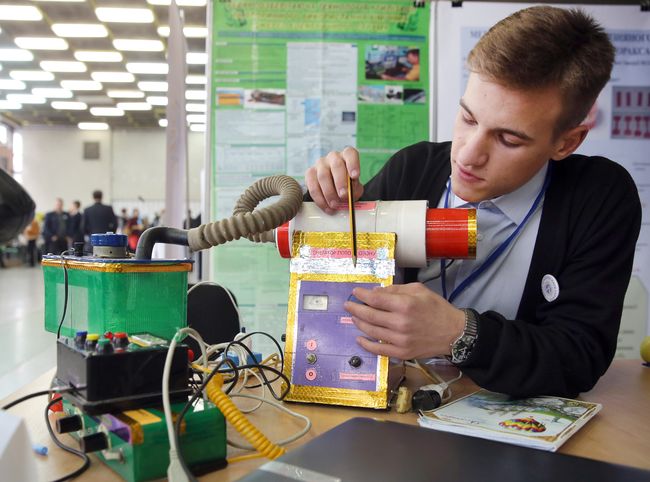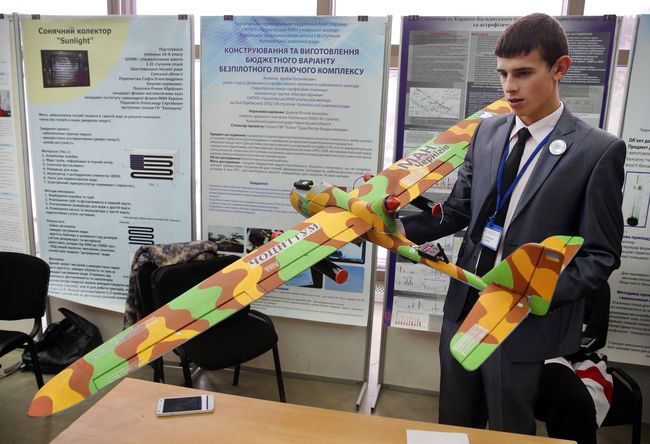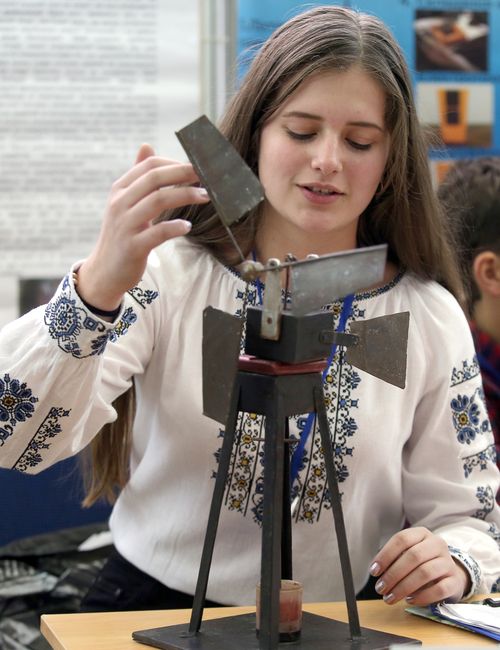On the feeling of science
Students of Minor Academy of Sciences presented their inventions at the final stage of “The Future of Ukraine” exhibition
About hundred stands have been placed in the lobby of the Kyiv Palace of Children and Youth recently. High school students from 23 regions of Ukraine brought to this place their inventions and developments in the most popular technical areas.
“The first such exhibition had representatives from three oblasts, the next one – from seven, and now we have almost all of them. These developments are so deep and talented, it is very difficult to single out any of them,” said Stanislav Dovhyi, president of Minor Academy of Sciences. The Day interviewed young scientists about their projects.
KEEPERS OF RESOURCES
Valeria SHAKHUNOVA, 11th-grader from Kherson, uses the example of her own home and Lyceum she studies in to prove that replacement of lamps and windows and rational use of electrical appliances might actually save money. Her calculations are impressive: not unplugging a TV-set from the socket can make you overpay nearly 100 hryvnias in a year!

Vitalia KRYSA from Halych was looking for an alternative to traditional energy resources. The schoolgirl thinks that small wind or hydroelectric power stations are the best solution for hard to reach areas. She believes that the future lies within small power engineering. And with good reason: her developments have already interested Halych’s Office for Water Utilities.
Olha YAROSHEVSKA brought an invention from Oleksandria, the purpose of which is to clean water from waste. She enthusiastically talks about her model, emphasizing the availability of materials. “Physics is my favorite subject at school,” says inventor. “Not only I know it, I understand it.” Of course, without understanding of the complex processes one can hardly implement their design into a working model.
WILL YOU PRINT A CHOCOLATE BAR?
3D-printing is becoming popular. Students of Minor Academy of Sciences also get that trend. At different stands are presented the models by Artem ARTEMENKO from Oleksandriia and Oleksii SALNIKOV from Lutsk. Artem’s model will work with clay. Pots and whistles are baked using the electromagnetic waves.

Oleksii has developed an extruder designed for printing from chocolate and wax, and is now working to create a multi-food printer. Who knows, maybe in a few years we will have revolutionized the concept of fast food and the perception of food in general.
TECHNOLOGY, FOR THE RESCUE!
Oleksandr CHEREDNYCHENKO from Zaporizhia Technical lyceum has combined physics and medicine. According to him, local cooling or warming of the human body will give doctors more time to provide emergency assistance. So the student has developed a compact device for this purpose. Indicators and sensors are working, but the model still has to pass a series of evidence-based medical experiments before being launched.

Maria KHATSKO from Lviv has created her own analog of “smart home” for homes that are already built. Spring, cork, board, electromagnet, telephone – and you can control your house even in the distance. This method is not only simple, but also cheap. Incidentally, the house can be taken care of by the robot nurse, created by Oleksandr POKHYLENKO. However, the main feature of his development is taking care of people with special needs, including children. The boy fashioned the first prototype from scrap materials. He is planning further to extend the wheelbase, set the automatic recharge and improve some of the robot’s functions.
To children dedicated the invention of Mykhailo TSYHANOK, student from Sievierodonetsk. A few beeps train the auditory memory of babies, and other family members can learn Morse code from it. The device is portable, so it can handle a travel or a power outage.

The monitor drone by Artem YAKOVLIEV from Chernihiv oblast can be used to watch after the household. It can monitor fields and forests. It can also be used in the ATO area. The plane climbs to a height of one kilometer or more, and may be in the air for 40 minutes. The researcher argues that it presents a good and inexpensive alternative to such appliances.
“I WANT TO HELP OUR PEOPLE”
IT section of the exhibition kept up. Anastasia MELNYK, 9th-grader from Bila Tserkva has created a series of training videos for students interested in computer science. They explain the intricacies of Lazarus programming environment. She argues that these lessons can be used both by students and teachers. “My friends watched these videos and thanked me for the explanations. I am very glad that I could help somebody,” said the student.
Ihor VOSHCHYK from Romny devoted his website to electronic music. According to his plan, visitors can not only know the latest music news, but master musical notation and create their own compositions. The boy also has clear plans for the project’s monetization.

An 11th-grader from Lutsk Oleh PONOMARENKO decided to use his web design skills to create an online volunteer center. This site will collect information about volunteers, their capabilities and needs. Oleh also has an answer for a reasonable issue of data protection: CAPTCHA (i.e. automated test for distinguishing between humans and computers) against bots, system administrators against human perpetrators. “So I want to help our army and people in general get out of a difficult situation,” explains the student. “I believe that the good side will prevail, our country will develop and there will be more useful projects.”
UBIQUITOUS SCIENCE
Minor Academy of Sciences has its branches in the cities and in small villages. One of them is headed by Vitalii DIEDKOV, secondary school teacher at Horbivtsi School in Chernihiv oblast. He is happy to combine science and technology, being the head of two sections – The Section of Aircraft Modeling and of the Young Researcher Section. Financial and material conditions are not the best, but the enthusiasm of mentors and students is saving the situation for now. Incidentally, this is why the exhibition has featured presentations by many students of secondary unspecialized schools.
Most children are seeking to dedicate their lives to pre-selected areas of research. However, some of them combine science with humanitarian interests. Some of the brilliant physicists are studying at the school of arts, dreaming about journalistic or artistic career and have not yet fully decided on their future. However, whatever be the path chosen by these children, their innovation activities have laid the foundation for change in their own lives and in the society as a whole.
Newspaper output №:
№71, (2016)Section
Society





